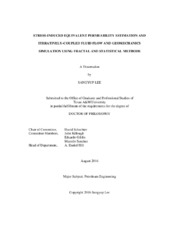| dc.description.abstract | Permeability and porosity are two of the key parameters of reservoir simulations. For naturally fractured reservoir simulations, when matrix porosity is negligible, it is important to estimate the proper fracture porosity and permeability to obtain accurate simulation results. However, it is very difficult to measure and estimate such parameters, due to factors such as the high heterogeneity of fluid and fracture properties, scale differences between the sampling window and actual reservoir domain, and so on.
In order to reduce the scale discrepancy error and properly describe natural-like fracture aperture characteristics, fractal theory has been adopted, and a cumulative distribution function of the generated fracture networks was calculated after a 1,000-time Monte Carlo simulation. P50 case was then selected as the reservoir fracture map.
The Discrete Fracture Network (DFN) approach can be effective when a limited numbers of fractures dominate the fluid flow in the fractured reservoir. However, if the reservoir has a very complex and large numbers of fractures, using the DFN approach to simulate a fracture flow will require significant computational effort and time. Therefore, in such cases the Equivalent Continuum (EC) approach is more suitable. I developed equivalent permeability calculation codes through a modified Oda’s algorithm; the heterogeneous nature of the fracture network was reflected by using the full tensor permeability method.
I developed Stress-Induced Permeability Changing (SIPC) coupling simulation codes to better describe the anisotropic behavior and more accurately reflect the geomechanical characteristics in the coupling simulation. For that, I combined DFN and EC schemes for the SIPC coupling simulation. During the coupling simulation, generated discrete fracture network and aperture data were imported into the coupling simulator, and openings/closings of the apertures due to stress/strain changes were calculated using a kriging scheme. Permeability and porosity were directly estimated via the aperture opening/closing calculation.
After a comparison of the FDM and iterative coupling simulations, it was observed that the SIPC coupling simulation successfully described the anisotropic characteristics of the directional permeability estimation, and reflected the reservoir properties in the coupling simulation. The combined DFN and EC approach was effectively applied to the stress-induced permeability changing reservoir coupling simulation. | en |


